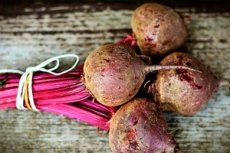
All iLive content is medically reviewed or fact checked to ensure as much factual accuracy as possible.
We have strict sourcing guidelines and only link to reputable media sites, academic research institutions and, whenever possible, medically peer reviewed studies. Note that the numbers in parentheses ([1], [2], etc.) are clickable links to these studies.
If you feel that any of our content is inaccurate, out-of-date, or otherwise questionable, please select it and press Ctrl + Enter.
Beets for gastritis
Medical expert of the article
Last reviewed: 04.07.2025

It is paradoxical, but the same product can be both useful and harmful to health depending on the diagnosis, method of its preparation and method of consumption. A clear example of this statement is beetroot for gastritis. In one case, it promotes the healing of inflammation, erosions inside the organ, in another it can harm and worsen the condition. So when can you eat beetroot for gastritis and in what form?
Indications
Beets are baked, boiled, eaten raw, and juiced. They can be a separate dish or included as an ingredient in others (hot red borscht and cold beetroot soup, salad). The term "gastritis" implies various conditions of the mucous membrane and different production of digestive juice. For what specific diagnosis is the vegetable indicated?
Beetroot for chronic gastritis
Chronic gastritis manifests itself in periodic outbreaks of symptoms such as heaviness and pain in the stomach after eating or on an empty stomach, bloating, belching, and sometimes nausea. Such reactions most often occur after alcohol, stress, and inappropriate food. Can beets cause such an exacerbation?
In case of gastritis with high acidity, raw vegetables or their juice are quite capable of causing harm, since their dietary fiber is very coarse, it contains caustic volatile substances, and when beets are broken down, they release hydrochloric acid, which is already in excess.
Baked or boiled beets will have the opposite effect. After heat treatment, beets retain their beneficial substances, favorably affecting the walls of the organ: inflammation is relieved, damage is healed, pathogenic microflora is destroyed. A reasonable single dose is 100 g, repeated several times a week.
The same rules apply to its use in the erosive form of the disease. Raw beets irritate the mucous membrane, it is too aggressive an environment for superficial erosions. But baking it in the oven, grating it and seasoning it with olive oil is not only tasty, but also healthy.
Beetroot for atrophic gastritis
Atrophic gastritis is characterized by thinning of the mucous membrane, insufficient secretion of gastric juice, gradual atrophy of the excretory glands. The process of digestion is sluggish, the motility of the organ is weakened. In this case, products that stimulate the production of hydrochloric acid are just right. At the same time, food should be chopped, delicate in relation to the mucous membrane.
The best thing that can be offered from the beet menu in the absence of exacerbation is juice, half with cabbage. Drinking in the morning 30-40 minutes before meals and adhering to a special diet, you can restore the functions of the stomach, restore the microflora, get rid of dysbacteriosis.
Beetroot for exacerbation of gastritis
Acute manifestation of gastritis symptoms forces a very responsible approach to nutrition and adherence to all recommendations of doctors. Is there a place for beets in them? The first day of the acute period is generally hungry, followed by a diet of pureed soups, viscous porridges with the gradual inclusion of boiled vegetables in the diet, including beets (therapeutic diet table No. 2).
Frequent inclusion of it in the menu can cause loose stools, so from time to time you can eat a small portion of the vegetable grated and sprinkled with vegetable oil.
Benefits
Beetroot is not only a tasty vegetable, but also healthy. Its main value is its low calorie content and high content of nutrients that are not lost during cooking. These are vitamins C, group B; minerals: silicon, zinc, manganese, iron, copper, molybdenum, potassium, calcium, magnesium; amino acids: betaine, arginine, histidine.
Beetroot is a rich source of phytochemical compounds, which includes ascorbic acid, carotenoids, phenolic acids and flavonoids. [ 1 ] Beetroot is also one of the few vegetables that contains a group of bioactive pigments known as betalains. [ 2 ] A number of studies have shown that betalains have high antioxidant and anti-inflammatory properties in vitro and in various animal models in vivo. [ 3 ], [ 4 ] This has sparked interest in the possible role of beetroot in clinical pathologies characterized by oxidative stress and chronic inflammation, such as liver disease, [ 5 ] arthritis and even cancer [ 6 ], [ 7 ]
The antioxidants in it prevent cell aging, iron prevents the development of anemia, and the large amount of fiber removes toxins and waste from the intestines, fights constipation, and promotes digestion.
Contraindications
Beetroot reduces the ability to absorb calcium, so if there is a deficiency, the root vegetable is contraindicated. Due to the high sugar content, it should be consumed with caution by diabetics, monitoring the glycemic index. It is not advisable for urolithiasis, as well as loose stools.

